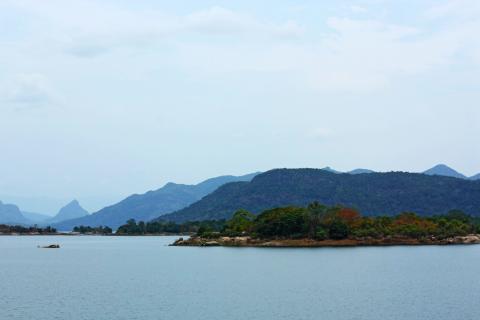Gal Oya National Park
The park was established in 1954 to protect the catchment area of the great Senanayake Samudra reservoir constructed by damming Gal Oya river and two other streams in 1948 in an irrigation project to open up some 162,000 hectares of forest for agriculture. Lying in the south east of Sri Lanka just west of Ampara, Gal Oya National Park has evolved naturally, untouched by the hand of man for countless centuries. Over 25,000 hectares of lush evergreen forest and open savanas thrive alongside the Senanayake Samudra lake – Sri Lanka’s largest inland body of water. To complete the scene, the water’s surface is peppered with islands, a reminder of the terraferma rising from the depths.
Gal Oya National Parkspreads over an area of 25,900 ha. Together with Senanayake Samudra Sanctuary (9,324ha), Gal Oya Valley North-East Sanctuary (12,432ha), Gal Oya Valley South-West Sanctuary (15,281ha), the whole Gal Oya Reservation makes an area of 62, 937 ha of wildlife conservation.
The elevation of the park varies from 30 meters to about 900 meters, Danigala, Nilgala, and Ulpotha mountains being the highest peaks. Rain is received during the North-eastern monsoon that brings in rain the eastern coast and northern plains result in an average annual rainfall of 1,700 milli metres at the park.
The vegetation of the national park is of three types: forest, shrub and grassland. About 45% of the park is covered by evergreen forest and a further 33% national park contains an area of Savanna like grasslands and 9% mountainous grasslands, 2% chena and 10% water bodies. The park is home to rare plants used as herbal medicine.The evergreen forest is dominated by Artocarpus sp., Halmilla (Berraya Cordifolia), Etamba (Mangifera Zeylancia) and Kalumediriya (Diopyros Chaetocarpa) and Ebony (Diospyros Ebenum). Gal Oya National Park is a sanctuary to 32 species of terrestrial mammals. The highest populations are common Langur (Presbytis Entellus), endemic Toque Macaque (Macaca Sinica), Leopard (Pathera Pardus kotiya) sloth bear (Melursus Ursinus), Elephant (Elephas Maximus), Wild Boar (Sus Scrofa), three species of deer and Water Buffalo (Bubalus Bubalis).

